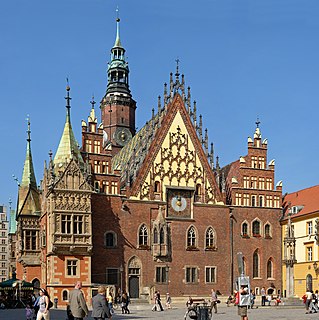| Brzeźnica | |
|---|---|
| Village | |
 | |
| Coordinates: 50°32′25″N16°44′00″E / 50.54028°N 16.73333°E | |
| Country | |
| Voivodeship | Lower Silesian |
| County | Ząbkowice Śląskie |
| Gmina | Bardo |
Brzeźnica [bʐɛʑˈɲit͡sa] (German : Briesnitz) is a village in the administrative district of Gmina Bardo, within Ząbkowice Śląskie County, Lower Silesian Voivodeship, in south-western Poland. [1] Prior to 1945 it was in Germany.

German is a West Germanic language that is mainly spoken in Central Europe. It is the most widely spoken and official or co-official language in Germany, Austria, Switzerland, South Tyrol (Italy), the German-speaking Community of Belgium, and Liechtenstein. It is also one of the three official languages of Luxembourg and a co-official language in the Opole Voivodeship in Poland. The languages which are most similar to German are the other members of the West Germanic language branch: Afrikaans, Dutch, English, the Frisian languages, Low German/Low Saxon, Luxembourgish, and Yiddish. There are also strong similarities in vocabulary with Danish, Norwegian and Swedish, although those belong to the North Germanic group. German is the second most widely spoken Germanic language, after English.
Gmina Bardo is an urban-rural gmina in Ząbkowice Śląskie County, Lower Silesian Voivodeship, in south-western Poland. Its seat is the town of Bardo, which lies approximately 10 kilometres (6 mi) south-west of Ząbkowice Śląskie, and 72 kilometres (45 mi) south of the regional capital Wrocław.

Ząbkowice Śląskie County is a unit of territorial administration and local government (powiat) in Lower Silesian Voivodeship, south-western Poland. It came into being on January 1, 1999, as a result of the Polish local government reforms passed in 1998. The county covers an area of 801.75 square kilometres (309.6 sq mi). Its administrative seat is Ząbkowice Śląskie, and it also contains the towns of Ziębice, Złoty Stok and Bardo.
It lies approximately 3 kilometres (2 mi) north of Bardo, 8 kilometres (5 mi) south-west of Ząbkowice Śląskie, and 69 kilometres (43 mi) south of the regional capital Wrocław.

Bardo is a town in Ząbkowice Śląskie County, Lower Silesian Voivodeship, in south-western Poland. It is the seat of the administrative district (gmina) called Gmina Bardo.

Wrocław is a city in western Poland and the largest city in the historical region of Silesia. It lies on the banks of the River Oder in the Silesian Lowlands of Central Europe, roughly 350 kilometres (220 mi) from the Baltic Sea to the north and 40 kilometres (25 mi) from the Sudeten Mountains to the south. The population of Wrocław in 2018 was 639,258, making it the fourth-largest city in Poland and the main city of Wrocław agglomeration.








